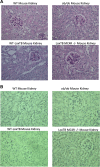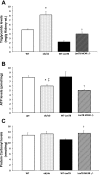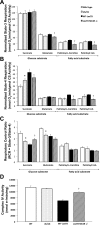Obesity-induced changes in kidney mitochondria and endoplasmic reticulum in the presence or absence of leptin
- PMID: 26290368
- PMCID: PMC4609921
- DOI: 10.1152/ajprenal.00188.2015
Obesity-induced changes in kidney mitochondria and endoplasmic reticulum in the presence or absence of leptin
Abstract
We investigated obesity-induced changes in kidney lipid accumulation, mitochondrial function, and endoplasmic reticulum (ER) stress in the absence of hypertension, and the potential role of leptin in modulating these changes. We compared two normotensive genetic mouse models of obesity, leptin-deficient ob/ob mice and hyperleptinemic melanocortin-4 receptor-deficient mice (LoxTB MC4R-/-), with their respective lean controls. Compared with controls, ob/ob and LoxTB MC4R-/- mice exhibit significant albuminuria, increased creatinine clearance, and high renal triglyceride content. Renal ATP levels were decreased in both obesity models, and mitochondria isolated from both models showed alterations that would lower mitochondrial ATP production. Mitochondria from hyperleptinemic LoxTB MC4R-/- mice kidneys respired NADH-generating substrates (including palmitate) at lower rates due to an apparent decrease in complex I activity, and these mitochondria showed oxidative damage. Kidney mitochondria of leptin-deficient ob/ob mice showed normal rates of respiration with no evidence of oxidative damage, but electron transfer was partially uncoupled from ATP synthesis. A fourfold induction of C/EBP homologous protein (CHOP) expression indicated induction of ER stress in kidneys of hyperleptinemic LoxTB MC4R-/- mice. In contrast, ER stress was not induced in kidneys of leptin-deficient ob/ob mice. Our findings show that obesity, in the absence of hypertension, is associated with renal dysfunction in mice but not with major renal injury. Alterations to mitochondria that lower cellular ATP levels may be involved in obesity-induced renal injury. The type and severity of mitochondrial and ER dysfunction differs depending upon the presence or absence of leptin.
Keywords: endoplasmic reticulum stress; kidney; leptin; melanocortin-4 receptor (MC4R); mitochondria; nephropathy; obesity.
Copyright © 2015 the American Physiological Society.
Figures





Similar articles
-
Impact of obesity on renal structure and function in the presence and absence of hypertension: evidence from melanocortin-4 receptor-deficient mice.Am J Physiol Regul Integr Comp Physiol. 2009 Sep;297(3):R803-12. doi: 10.1152/ajpregu.00187.2009. Epub 2009 Jul 15. Am J Physiol Regul Integr Comp Physiol. 2009. PMID: 19605765 Free PMC article.
-
Chemical Chaperone PBA Attenuates ER Stress and Upregulates SOCS3 Expression as a Regulator of Leptin Signaling.Biochemistry (Mosc). 2021 Apr;86(4):480-488. doi: 10.1134/S0006297921040088. Biochemistry (Mosc). 2021. PMID: 33941068
-
Obesity promotes melanoma tumor growth: role of leptin.Cancer Biol Ther. 2009 Oct;8(19):1871-9. doi: 10.4161/cbt.8.19.9650. Cancer Biol Ther. 2009. PMID: 19713740 Free PMC article.
-
[The Mechanisms and Pharmacological Strategy for Treatment of ER Stress-induced Metabolic Syndrome].Yakugaku Zasshi. 2016;136(6):827-30. doi: 10.1248/yakushi.15-00292-5. Yakugaku Zasshi. 2016. PMID: 27252062 Review. Japanese.
-
Dialogue between endoplasmic reticulum and mitochondria as a key actor of vascular dysfunction associated to metabolic disorders.Int J Biochem Cell Biol. 2016 Aug;77(Pt A):10-14. doi: 10.1016/j.biocel.2016.05.011. Epub 2016 May 18. Int J Biochem Cell Biol. 2016. PMID: 27208732 Review.
Cited by
-
Renal Cellular Autophagy in Obesity: Boon or Bane?Semin Nephrol. 2021 Jul;41(4):349-357. doi: 10.1016/j.semnephrol.2021.06.006. Semin Nephrol. 2021. PMID: 34715964 Free PMC article. Review.
-
Mediation Effect of Platelet Traits on Associations of Central Obesity with Aging Biomarkers in Rural Adults of Henan, China.Nutrients. 2022 Aug 31;14(17):3597. doi: 10.3390/nu14173597. Nutrients. 2022. PMID: 36079858 Free PMC article.
-
The Role of the Unfolded Protein Response on Renal Lipogenesis in C57BL/6 Mice.Biomolecules. 2021 Jan 7;11(1):73. doi: 10.3390/biom11010073. Biomolecules. 2021. PMID: 33430288 Free PMC article.
-
Six months of physical inactivity is insufficient to cause chronic kidney disease in C57BL/6J mice.bioRxiv [Preprint]. 2024 Aug 30:2024.08.29.610415. doi: 10.1101/2024.08.29.610415. bioRxiv. 2024. PMID: 39257785 Free PMC article. Preprint.
-
Impact of leptin deficiency compared with neuronal-specific leptin receptor deletion on cardiometabolic regulation.Am J Physiol Regul Integr Comp Physiol. 2019 Oct 1;317(4):R552-R562. doi: 10.1152/ajpregu.00077.2019. Epub 2019 Aug 14. Am J Physiol Regul Integr Comp Physiol. 2019. PMID: 31411897 Free PMC article.
References
-
- Abdurrachim D, Ciapaite J, Wessels B, Nabben M, Luiken JJ, Nicolay K, Prompers JJ. Cardiac diastolic dysfunction in high-fat diet fed mice is associated with lipotoxicity without impairment of cardiac energetics in vivo. Biochim Biophys Acta 1842: 1525–1537, 2014. - PubMed
-
- Ahren B, Mansson S, Gingerich RL, Havel PJ. Regulation of plasma leptin in mice: influence of age, high-fat diet, and fasting. Am J Physiol Regul Integr Comp Physiol 273: R113–R120, 1997. - PubMed
-
- Alicic RZ, Patakoti R, Tuttle KR. Direct and indirect effects of obesity on the kidney. Adv Chronic Kidney Dis 20: 121–127, 2013. - PubMed
Publication types
MeSH terms
Substances
Grants and funding
LinkOut - more resources
Full Text Sources
Other Literature Sources
Medical
Molecular Biology Databases
Research Materials
Miscellaneous

